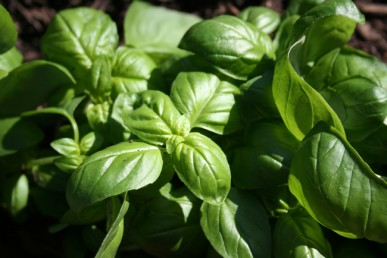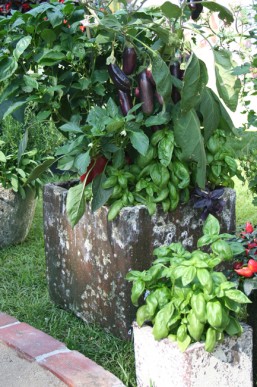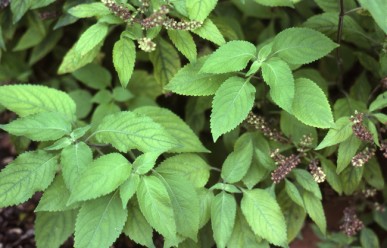Nothing can compare with the first fresh sprig of basil picked in spring and if you haven’t already planted your basil, now is the time to put it in. It’s hard to believe that such a deliciously aromatic herb could have such a contradictory lineage. Basil is native to tropical and subtropical regions of Asia, Africa and Central and South America, but the main centre of diversity appears to be Africa. It has been cultivated for more than 4000 years. The sixteenth century English herbalist, John Gerard, believed that basil would stimulate the heart and ‘taketh away melancholy and maketh a man merry and glad’ but early Greek and Roman physicians said that it would only grow well if it were planted ‘amid vile shouts and curses’. In the language of flowers, basil means hatred, but it can also signify goodness and love.
Basil also had the bizarre reputation of giving birth to scorpions. This conjures up images straight from Edward Lear’s nonsense botany but probably simply comes from the fact that basil was often grown in a pot and insects like scorpions often seek out the cool retreat found underneath a pot. Basil is a source of essential oils and aroma compounds, a culinary herb, and an attractive, fragrant ornamental. The seeds contain edible oils and a drying oil similar to linseed. Extracts of the plant are used in traditional medicines, and have been shown to contain biologically active constituents that will kill insects, fungi, microbes and nematodes.
Naming basil
The identification and botanical classification and naming of basil plants is a very confused area, made more so because of the plants polymorphic nature and cross-pollination resulting in large numbers of subspecies, varieties and forms. More than thirty different species of basil have been recorded over the years, as well as at least sixty different varieties and cultivars of sweet basil alone. Listed below are the species, varieties and cultivars most commonly available in Australia.
How to grow
Basils are warm-climate annuals or short-lived perennials. In temperate regions, grow them from seed planted in containers protected from frost in early spring, or purchase plants in late spring. Basils do not thrive in temperate regions until it has really started to warm up in late spring or early summer. The mistake most commonly made in these regions is to plant basil into the garden too early in the season when the cold and damp quickly kills it. To protect young basil plants from unexpected cold snaps, cut the top and bottom from a plastic drink bottle and leave it around the plant until it is well established. In tropical regions, grow basil from seed or the perennial forms can be grown from tip cuttings taken in spring.
Basil grows best in well-drained, composty soil with plenty of added nutrients. The ideal place for smaller growing annual forms is in the vegetable garden near the tomatoes, as basil helps to keep tomato plants healthy and to repel pests. Perennial basils grow into medium sized bushes so need more room. In temperate regions, plant perennial basil in a sheltered warm spot where there is no chance of frost and preferably where they won’t get too wet during cold weather. Even with these precautions it is hard to keep them alive through the winter. It they do survive then cut back by about one third in early spring. In the tropics, cut them back in late autumn. Some suppliers are currently marketing a basil scented mint as perennial basil, check the botanical name and if it is Mentha rather than Ocimum then it is not a true basil and can’t be used in the same ways.
In temperate regions, all basils need to be grown in full sun, but in the tropics and sub-tropics they will tolerate shade for much of the day. Basil also needs moisture during hot weather and it will not tolerate frost. Protect young seedlings from slugs and snails. As annual plants begin to come into flower, nip out the buds to encourage more leaf growth but towards the end of summer let at least one plant go to seed and then collect the seed for next year’s crop. All basils grow well in pots but the dwarf varieties lend themselves particularly to pot culture where they are not only beautiful but also useful.
Pest-repellent
Since basil repels a range of problem insects, including flies and mosquitoes, a pot of basil can be moved around to wherever it is most needed. Italian fishermen and sailors often have a pot of basil growing in the wheelhouse or galley to keep problem pests away. Tests on sacred basil oil have shown it to have insecticidal activity and in Asia it is rubbed on the skin to repel mosquitoes. In the vegetable garden basil will help protect nearby plants of cabbages, beans and tomatoes and, if planted near cucurbits , will help prevent downy mildew.
Medicinal
Basil is used medicinally, usually made into a tea by pouring boiling water over the fresh leaves. A cup of this tea acts as a sedative and to cure nausea and stomach cramps. It also aids digestion and relieves constipation. Basil, rubbed on a sting or bite, reduces inflammation and pain and stops the itch.
The intensely purple pigmented basils are also a source of anthocyanins. The large leafed cultivars ‘Purple Ruffles’ and ‘Dark Opal’ had an average extractable total anthocyanin content of about 18 mg per 100 g fresh tissue. By comparison, purple grapes have around 25, purple plums about 16.
Anthocyanin pigments from fruits have been used to improve vision and treat circulatory disorders. They are also believed to be anti-inflammatory, beneficial for treating diabetes and ulcers and may have antiviral and antimicrobial activities. The chemical basis for these desirable properties is believed to be related to their antioxidant activity. Although the anthocyanins in basil have not yet been used in this way, the high levels in some cultivars suggest that this is possible for the future.
Basil oils
Basil is also a source of essential oils that are used in foods, flavourings , and fragrances (perfumes, soaps and shampoos) as well as confectionery products and the liqueur chartreuse. The various scents and flavours have been described as spicy, lemon, rose, camphor, licorice, woody, and fruity. The rich spicy pungent aroma of sweet basil is due to the presence the aroma compounds linalool, methylchavicol and cineole.
The predominant aroma compound in clove or tree basil is eugenol, in perennial or camphor basil it is camphor, in sacred basil it is b-caryophyllene and in Thai basil it is methylchavicol. Several red varieties are rich in linalool while lemon-scented basils are high in cineole. These compounds give rise to the very different scents and flavours seen in all the different basils and may be used in the future to classify and separate the different types. There is also experimentation on the different types for future uses, for example the camphor-containing oils have been shown to have anti-bacterial properties.
Cooking with basil
Basil lends itself to a huge range of different dishes and is used in almost every culture through the world. The different flavours of basil dictate its different uses. Sweet basil is used with tomatoes, spaghetti sauces (like pesto, see the recipe below), mushrooms, pea and lentil soups, cream cheese, cucumbers, eggs, rice and salads. It is especially good when finely chopped and added to salad dressing. In Asia, raw basil leaves are eaten with raw vegetables and a spicy dip or served with other fresh herbs and salad vegetables as a side dish. They also add a handful of leaves, just before serving, to stir-fried meats like chicken or beef. In Ethiopia, basil is added to chilli sauces and mashed into ghee. Anise-flavoured Thai basil is added to many dishes, especially stir-fried meats while lemon basil can be fried with seafood and baked with fish. Sacred basil has a sweet, spicy, pungent flavour and is used in salads, as a potherb and added to stir-fries and curries.
Pesto sauce
1 cup fresh basil leaves
3 tablespoons pine nuts
3 tablespoons grated parmesan cheese
2 cloves garlic (optional)
2 tablespoons of olive oil
2 fresh basil leaves
Combine the basil leaves, pine nuts, parmesan cheese and garlic in a large pestle and mortar or food processor, and puree. Slowly add the olive oil while continuing to puree. Use with pasta, potatoes or simply on toast. Garnish with the two fresh basil leaves. Pesto sauce can be kept in the refrigerator in a sealed jar for a couple of weeks.
Different types of basil
Ocimum basilicum — Sweet basil. An annual that grows to 50 cm with oval-shaped leaves and green bracts with white flowers that grow in tapering spikes at the top of the plant. It has a warm clove-like scent and flavour. There are numerous cultivars, all of which can be used in cooking, to repel pests and medicinally. The following is a list of some of those available.
‘Anisette’ — Anise basil with anise-basil scented leaves.
‘Cinnamon’ — Cinnamon basil with spicy cinnamon scented leaves.
‘Crispum’ — Lettuce-leaf basil grows as a large bush with large crinkly green leaves with the true basil scent and flavour.
‘Greek Mini’ — Dwarf form with tiny leaves and a spicy aroma and flavour.
‘Green Bouquet’ — Dwarf form with tiny leaves which makes a good pot-plant or edging plant.
‘Green Ruffles’ — Large frilly green leaves.
‘Mammoth’ — Large plant with a very large leaf and fine flavour.
‘Spicy Globe’ — Compact dwarf form with spicy leaves and white flowers.
‘Thai’ — Purple stems and deep green leaves with strong, anise-clove flavour, mauve flowers with deep purple bracts. Also known as liquorice basil and sometimes given the species name of O. thyrsiflora. There are now several cultivars of this basil including ‘Siam Queen’.
var. purpurascens — Purple basil resembles sweet basil except that it has attractive purple leaves and pink flowers. The flavour is stronger and less sweet.
var. purpurascens ‘Purple Ruffles’ — Large purple leaves with wavy edges.
O. americanum — Lime or Hoary basil. An annual with long pointed leaves and a zesty lime flavour. This basil is also called O. canum
O. x citriodorum — Lemon basil is an annual that grows as a small delicate shrub with lemon-basil scented leaves.
O. gratissimum — Clove basil, tree basil, East India basil. This shrubby perennial basil has long, lime green leaves and pale yellow flowers. Sweet clove scent. In frost-free areas it can reach 2 m in height.
O. kilimandscharicum— Perennial basil, camphor basil, African blue basil needs to be protected from frosts and is very susceptible to damping off. It has slightly narrower, more pointed leaves than sweet basil, purple bracts and white flowers.
O. minimum — Bush basil is an annual with small leaves and grows to only 20 cm; good container plant.
O. tenuiflorum — Sacred basil is a perennial that grows as a small shrub with soft, hairy leaves and pink flowers. It has a strong, pungent, clove like scent. It is native to the far north of Australia, India, Malaysia and western Asia. This basil is sacred to Hindus and is used in funeral rites, planted around temples and generally believed to bring good luck. It is also commonly cultivated in India as a malarial fumigant. Sacred basil is also found growing wild in Northern Australia (mostly inland Queensland and the Northern Territory) where it is often called bush tealeaf. Aboriginal people of the Northern Territory prepared hot, clove-scented infusions from the plant that were used to treat respiratory problems, dysentery, fever and sickness.
Mail order suppliers of basil plants and seeds
All Rare Herbs
www.allrareherbs.com.au
Digger’s Seeds
www.diggers.com.au
Eden Seeds
www.edenseeds.com.au
Green Harvest
www.greenharvest.com.au
New Gippsland Seeds and Bulbs
www.newgipps.com.au
Greenpatch Organic Seeds
www.greenpatchseeds.com.au











